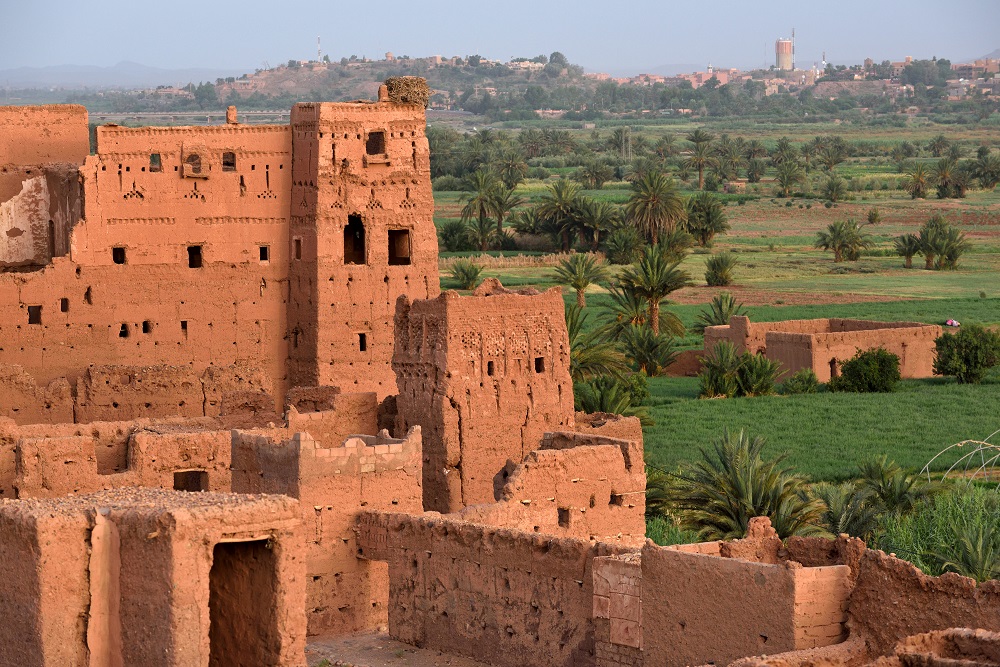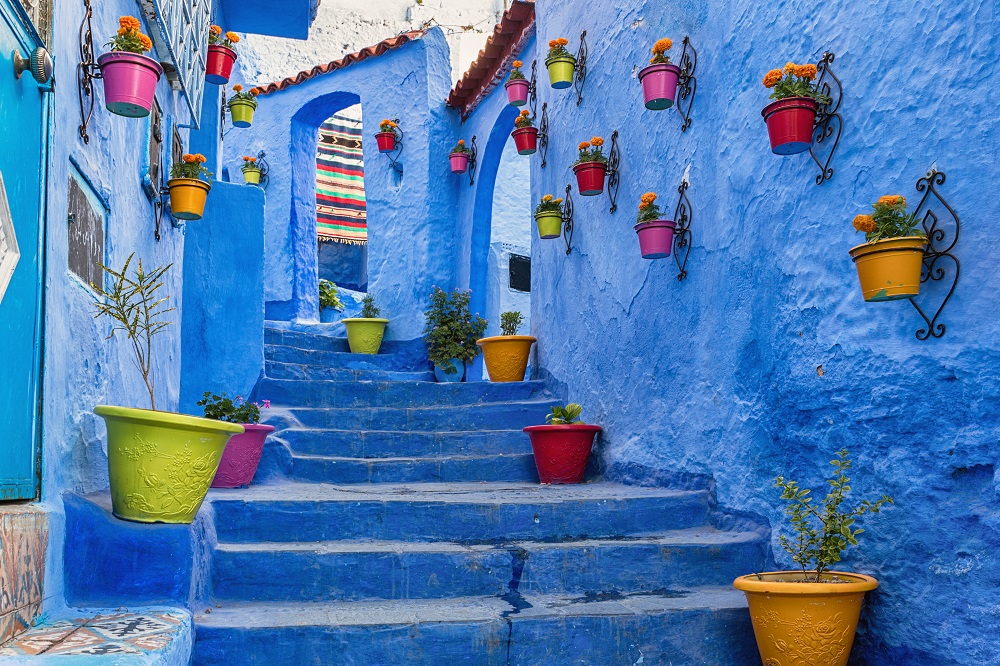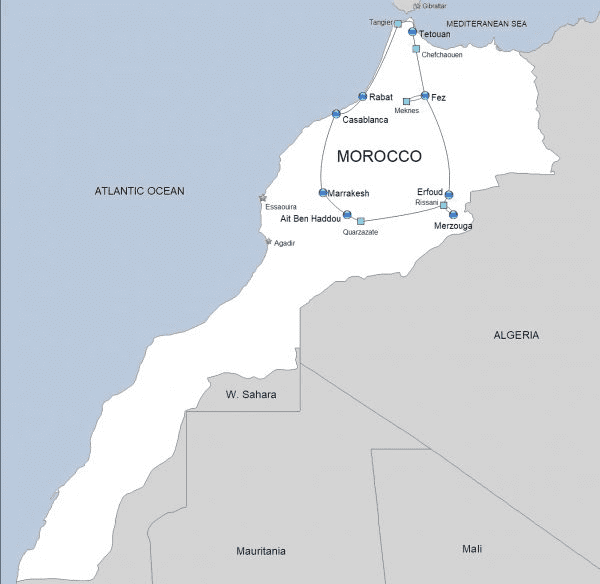





Jewish people may have misgivings about visiting a Muslim country, but beautiful Morocco is not only safe, it is welcoming. Even with the decline of the Moroccan Jewish population after the formation of Israel, Jews have continued to live here eating kosher food, attending Jewish schools and attending one of many synagogues. The cemeteries, too, are beautifully tended to often by Moroccan « shomrim » (custodians) who take their duties seriously and faithfully. Visit a land which has enjoyed the influence of Jewish life for centuries, incorporating it into its very fiber. Most cities in Morocco feature a Jewish Quarter (or Mellah) and many were the birthplace of some of our most prominent Rabbinical scholars and Kabbalists. What other country offers a touch of Arabia, a touch of Africa, the starry Sahara desert (with a luxurious tent camp experience), a beautiful Sephardic presence and a sweet welcoming populace. Come to Morocco and feel the magic yourself.
Casablanca – Rabat- Tangier- Tetouan – Chechaouen – Fez – Erfoud – Merzouga -Ait Ben Haddou – Marrakesh
Accommodation
Casablanca, 1 night Hotel le Doge (Relais & Chateaux)
Tangier, 2 nights Royal Hotel
Fez, 3 nights Marriott Jnan Palace Hotel
Erfoud, 1 night Kasbar Xaluca
Merzouga, 1 night Luxury Tent Camp
Ait Ben Haddou, 1 night Riad Ksar Ighnda
Marrakesh, 2 nights Radisson Blu Hotel Carre Eden
Meals
11 Breakfasts
Your land arrangements include:
Private arrival and departure transfers
Private touring and sightseeing
Local guides with 5 or less travelers
Full time Tour Director with 6 or more travelers
Deluxe Hotels in Casablanca, Tangier, Tetouan, Fez and Marrakesh
First Class hotels in Erfoud, Merzouga and Ait Ben Haddou
Breakfast daily at the hotels
Complete program with insights to the Jewish history in Morocco
All taxes and fees
Your land tour does not include:
Airfare to Casablanca and back from Marrakesh
Departure taxes, fuel surcharges and airport improvement fees
Porterage at airports and hotels
Meals and beverages not mentioned
Early check in/late checkout
Optional tours
Insurance though not included is strongly recommended
Gratuities of a purely personal nature such as laundry and valet service
Tipping to guide, driver and hotel staff
E. & O.E.
Pre/Post Tours:
We can accommodate pre/post tour arrangements in conjunction with this departure
Passport & Visa:
No visa is required for travel to Morocco. Always make sure your passport is valid for at least 6 months after the tour ends
For information or reservations please contact Janice Snider.
Day 1 Monday Arrival in Casablanca
Arrival in Morocco at Casablanca’s Mohammed V Airport. Casablanca, Morocco’s largest city was founded by Berber fishermen in the 10th Century BC. Casablanca’s 4,500 Jews live proudly – worshipping in over 30 synagogues, eating in kosher restaurants, enjoying recreation at Jewish Community Centers and attending Jewish schools. Moreover, this city boasts a Jewish Museum created by the Jewish community as well as the Foundation of Jewish-Moroccan Cultural Heritage, that is (for many reasons) unique in the Arab world. Begin your tour of Casablanca with a visit to Temple Beth-El, the main Jewish Synagogue and the centerpiece of a once gigantic Jewish community. Its stained glass windows are uniquely beautiful and draw tourists from around the world. Optional visit to Temple Em Habanim was founded in 1942 by brothers Moise and David Bendayan. The curriculum included Hebrew, Arabic and French. Time permitting you will also visit the last Moroccan Jewish day school, Neve Chalom. Hyatt Regency Hotel.
Day 2 Tuesday Casablanca – Rabat – Tangier
This morning visit the striking and unusual Museum of Moroccan Judaism built with the support of both Moroccan Jews and non-Jews in 1997. The Museum of Moroccan Judaism is a Jewish museum in the Oasis neighborhood of Casablanca. Established in 1997, it is the only museum devoted to Judaism in the Arab world. Next we tour Casablanca’s uniquely picturesque Jewish Mellah (Quarter). While Jews no longer live within the quarter, Kosher butchers are still found in the old market. The adjacent Jewish cemetery is impressive with well-kept markers in French, Hebrew and Spanish. (Casablancans celebrate an annual prayer festival at the Tomb of the Jewish “saint” Eliahu). We are now on our way to the capital of Morocco, Rabat founded in the 12th century on the Atlantic Ocean at the mouth of the River Bou Regreg opposite the city of Salé. Our tour will include the Royal Palace constructed in 1864 serving as the residence of Moroccan royalty. The interior is closed to visitors. The unfinished Hassan Tower a 140 foot red stone minaret was intended to be the largest minaret in the world and was commissioned near the end of the 12th century.
The Mausoleum of Mohammed V adorned with stained glass, white marble and a gorgeous dome is crowned with green tiles and lavishly decorated inside with a wealth of traditional artwork. It is the final resting place of King Hassan II and Prince Abdallah, his two sons. Royal guards wear dress uniforms and visitors are expected to dress respectfully (long clothes, covered shoulders and ideally a headscarf for women). Our final stop is Sale, birthplace of Rabbi Hayyim Ben Moses Attar, an 18th century Kabbalist. In the late afternoon we arrive in Tangier at the western entrance of the Strait of Gibraltar. Hilton Hotel. (B)
Day 3 Wednesday Tangier
Jews of Morocco were already living in the coastal port city of Tingis (Tangier) during the Phoenician era but the community really came into prominence in the 18th century. In the 20th century – particularly after 1948 – many Jewish families chose to emigrate from here to South America particularly to Venezuela. (It is worth noting that Morocco’s Jews were never chased out.) We begin our sightseeing with a visit to its bustling Medina. We will walk through the maze of shops and passageways upon occasion breaking into an open square with vendors hawking their wares. See the Grand (Big Square) a good place to watch the world go by. The Petit Socco (Little Square) was once the meeting place for writers, painters and other creative types. Next is Synagogue Street whose very name attests to the rich Jewish presence here. Almost all the synagogues of Tangier’s medina were placed in the Rue Synagogue though today most of them have now disappeared. See Kasbah Square with its gorgeous views overlooking the ocean and Spanish coast. Our final stop will be at the Hercules Caves at Cape Spartel. This archaeological complex is 14 kms. west of Tangier and has two openings, one to the sea and one to land. According to legend, the Phoenicians created the sea opening. The cave is part natural and part man-made. According to mythology, the Roman God Hercules stayed and slept in this cave before doing his 11th labour. Hilton Hotel. (B)
Day 04 Thursday Tangier – Tetouan – Chechaouene – Fez
Today we journey to the exotic town of Tetouan. This area once boasted an important Jewish community mainly coming from Medieval Spain. Some of these scholars were among our most eminent Sephardic Rabbis such as Jacob Marrache, Menahem Attias and Itshaq Ben Oualid. Enjoy a visit to the medina, view the exquisite exterior of the Royal Palace and stroll through the Mellah or Jewish Quarter. Then continue to Chechaouene, a mystical, blue-hued town nestled between two mountains. (The blue paint, uniquely used throughout is thought to be a Jewish choice.) Tour its Medina, the Kasbah, Uta El Hammam Square and the Great Mosque (Jamaa El Kebir) which dates back to the 15th century. Later continue to Fez. Marriott Jnan Palace Hotel. (B)
Day 05 Friday Fez
The entire day will be devoted to visiting Fez, the religious capital of Morocco. Fez was equally renowned during the Middle Ages for its Talmudic studies and eminent Rabbis (including the great Maimonides). Its numerous synagogues testify to the importance as well as comfort of the Jewish community here. Visit the old Mellah (Jewish Quarter) as well as the caringly kept Jewish cemetery with its engraved tombs. Continue to Ibn Danan (a recently renovated synagogue), the Attarine and Bou Inania Medersas (the greatest of Fez’ colleges) and the scenic Nejjarine Fountain, an intricately constructed fountain attached to an important building. You will also see Fez’s impressive Al Karouine Mosque, one of the oldest and most illustrious in the Muslim World. You will also see Fez’s impressive Karaouine and Andalous Mosques. The Al-Karaouine Mosque is one of the oldest and most illustrious in the Muslim world. It was the first university of Morocco and has amongst its alumni famous scholars such as Ibn Khaldoun, Ibn Al Khatib and Averroes taking its name from the district in which it was erected, that of the Kairouan refugees. It has a capacity of 20,000 people. The Al-Andalus Mosque is situated in the neighbourhood of Arroyo del Cuarto in the city of Málaga, Andalusia, Spain. The mosque is 4,000 square meters in size and has two entrances, one for men and one for women. It has a kindergarten, an auditorium for 200 people, three prayer rooms, classrooms, library or Arabic classes are taught among other services. It has a capacity for 1,000 people making it one of the largest mosques in Europe. The minaret is 25 meters high. In the afternoon we continue to Fez el Jdid and view the exterior of the Royal Palace and the adjacent new Mellah. Marriott Jnan Palace Hotel. (B)
Day 06 Saturday Fez – Meknes – Volubilis – Fez
Shabbat Shalom. You may choose to rest or join an optional tour to nearby Meknes. A few centuries ago, Meknes had an important Jewish community with Spanish origins. Its prominent Rabbis included Raphael Berdugo, Daniel Toledano and David Benmidan, the Patron of Meknes. Although reduced in size, the Jewish community is still very active in commerce. Visit the Ismaïlian capital famous for its long walls with its monumental gates such as Bab Mansour, the Old and New Mellahs and the Royal stables (Arabic horses, you may know are among the most prized in the world). Next continue to the ruins of the Roman city of Volubilis where you will see a Hebrew epitaph proving the existence of a Jewish community during the Roman occupation. Late return to Fez. Marriott Jnan Palace Hotel. (B)
Day 07 Sunday Fez – Ifrane – Erfoud
This morning we leave for Erfoud through the mountains and cedar woods of the Middle and High Atlas Mountains. En route pass Ifrane, a charming ski resort and Azrou, an important handicraft center specializing in cedar wood. After crossing the spectacular Zad Pass arrive in the Sahara and continue along valleys dotted with palm trees. Upon arrival in Erfoud, check-in to the Hotel. Kasbar Xaluca. (B)
Day 8 Monday Erfoud – Rissani – Merzouga
Today is devoted to the golden sands of the Sahara. Drive towards Merzouga located at the edge of seemingly endless sand dunes. Upon arrival at the Sahara’s Luxury Tent Camp, enjoy an elegant Lunch. In the afternoon ride into the desert on a caravan of camels. Later return to Camp and enjoy time at leisure and to witness the sky turn unimaginably colourful (then unimaginably starry) as the sun sets over the Sahara. Dinner at the Camp. Luxury Tent Camp. Alternatively, return to Kasbar Xaluca in Erfoud. (B)
Day 9 Tuesday Merzouga – Erfoud – Ouarzazate – Ait Ben Haddou
This morning we leave for the Dades Canyons for a visit of this naturally beautiful sight, before continuing on to Ouarzazate via the Thousand Kasbah Route and the Dades Valley. Morocco and scenic Ouarzazate is a favorite for the film industry and many iconic movies have been shot here. Stop at the Film Museum to learn about this history. Continue to the fortified village of Aït Ben Haddou, the most uniquely spectacular fortress in the South of Morocco which has likewise served as the uniquely exotic setting for many films. Riad Ksar Ighnda. (B)
Day 10 Wednesday Ait Ben Haddou – Marrakesh
Enjoy a morning tour in quiet Ait Ben Haddou before visitors arrive from Ouarzazate or Marrakesh. Afterwards, depart for Marrakesh via the Tizi’n’Tichka pass which offers an impressive landscape in the heart of the Atlas Mountain chain. Marrakesh founded by the Almoravides at the end of the 11th Century is Morocco’s second oldest Imperial city and is known as “the Pearl of the South.” Upon arrival in Marrakesh begin touring with a visit to the Majorelle Garden – once the horticultural pride of designer Yves Saint Laurent – and the fascinating new city. Radisson Blu Hotel Carre Eden. (B)
Day 11 Thursday Marrakesh
Marrakesh’s strong Jewish community (like many others in the Arab world) specialized in commerce and handicrafts. There are still some prominent Jewish families settled in this attractive city. Continue your tour of mystical Marrakesh with a visit to the Jewish Mellah, Dar Si Saïd Museum, Bahia Palace and the Menara Garden. In the afternoon visit souks and handicraft quarters (and perhaps watch a snake charmer or two) at the famous Djemaa El Fna square with its non-stop entertainment. Radisson Blu Hotel Carre Eden. (B)
Day 12 Friday Marrakesh – home flights
Time for an early breakfast then transfer to the airport for your return flight or join a post tour extension of Morocco. (B)
B=Breakfast L=Lunch D=Dinner